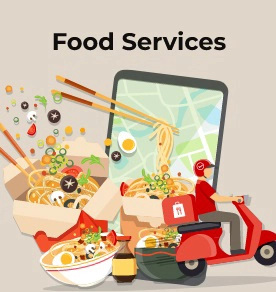 As India’s dining scene continues to evolve, one thing remains constant: Rohit Khattar’s unwavering commitment to excellence, innovation, and adaptability.
As India’s dining scene continues to evolve, one thing remains constant: Rohit Khattar’s unwavering commitment to excellence, innovation, and adaptability. From thematic art displays to live music, storytelling events, and culinary theater, restaurants are creating immersive spaces where food meets culture.
From thematic art displays to live music, storytelling events, and culinary theater, restaurants are creating immersive spaces where food meets culture. Attention to detail is very necessary as it will lead to long-term association with the guests and worth of mouth will improve the sales of the hotels.
Attention to detail is very necessary as it will lead to long-term association with the guests and worth of mouth will improve the sales of the hotels. Yet, amidst the glitter and shine of modernity, there’s a quiet shift happening. More and more, people are seekingspaces that offerserenity—a return to thenatural.
Yet, amidst the glitter and shine of modernity, there’s a quiet shift happening. More and more, people are seekingspaces that offerserenity—a return to thenatural. The narrative of growth in India’s retail sector is no longer confined to its major metropolitan centres.
The narrative of growth in India’s retail sector is no longer confined to its major metropolitan centres. In an exclusive interaction with Chef Adwait Anantwar, Chef Partner at the popular restaurant INJA from Atelier House Hospitality talks about creating uniqueness and creativity in his restaurant.
In an exclusive interaction with Chef Adwait Anantwar, Chef Partner at the popular restaurant INJA from Atelier House Hospitality talks about creating uniqueness and creativity in his restaurant. According to one digital analytic platform 41 percent restaurants don't ever make any store level profitability and shut down within three years of opening.
According to one digital analytic platform 41 percent restaurants don't ever make any store level profitability and shut down within three years of opening. The city’s emphasis on developing world-class infrastructure has made it an attractive location for setting up both retail outlets and production facilities.
The city’s emphasis on developing world-class infrastructure has made it an attractive location for setting up both retail outlets and production facilities. The market for vegan food has expanded significantly in recent years. At a 13.1% compound annual growth rate (CAGR), it will increase from $24.58 billion in 2023 to $27.8 billion in 2024.
The market for vegan food has expanded significantly in recent years. At a 13.1% compound annual growth rate (CAGR), it will increase from $24.58 billion in 2023 to $27.8 billion in 2024. Projections suggest that by 2024, the market will reach a revenue of $15.1 billion, with an anticipated annual growth rate of 6.10 percent from 2024 to 2028.
Projections suggest that by 2024, the market will reach a revenue of $15.1 billion, with an anticipated annual growth rate of 6.10 percent from 2024 to 2028. While cloud kitchens offer numerous benefits, they are not without challenges. The lack of face-to-face guest interaction can pose a hurdle to build a brand identity.
While cloud kitchens offer numerous benefits, they are not without challenges. The lack of face-to-face guest interaction can pose a hurdle to build a brand identity. Running a restaurant is never easy, regardless of location, and the challenges are often similar worldwide.
Running a restaurant is never easy, regardless of location, and the challenges are often similar worldwide. Biryani has firmly established itself as the most-ordered dish on Swiggy, amassing an impressive 7.6 crore orders in the last 12 months.
Biryani has firmly established itself as the most-ordered dish on Swiggy, amassing an impressive 7.6 crore orders in the last 12 months. Whenever I come back to India my heart is filled with joy and happiness to see how the hospitality industry is growing and progressing.
Whenever I come back to India my heart is filled with joy and happiness to see how the hospitality industry is growing and progressing. West Bengal has received investment proposals worth INR 2000 crore in the food processing sector.
West Bengal has received investment proposals worth INR 2000 crore in the food processing sector. According to a recent report by Google and Boston Consulting Group (BCG), the Indian food delivery industry is projected to grow from $4 billion in 2019 to over $8 billion by 2023.
According to a recent report by Google and Boston Consulting Group (BCG), the Indian food delivery industry is projected to grow from $4 billion in 2019 to over $8 billion by 2023. This growth in the F&B sector will not only cater to the increasing number of visitors but also enhance the overall appeal of Jaipur as a vibrant and dynamic tourist destination.
This growth in the F&B sector will not only cater to the increasing number of visitors but also enhance the overall appeal of Jaipur as a vibrant and dynamic tourist destination. Instead of a full-scale overhaul, Indian QSRs could implement digital solutions gradually, starting with mobile ordering and loyalty programs, allowing for smoother transitions and customer adaptation.
Instead of a full-scale overhaul, Indian QSRs could implement digital solutions gradually, starting with mobile ordering and loyalty programs, allowing for smoother transitions and customer adaptation. According to estimates by the Confederation of Indian Alcoholic Beverage Companies (CIABC), Indian single malts accounted for approximately 53 percent of total sales in 2023.
According to estimates by the Confederation of Indian Alcoholic Beverage Companies (CIABC), Indian single malts accounted for approximately 53 percent of total sales in 2023. Catering has become a vital part of the revenue strategy for many cloud kitchens and traditional restaurants. By diversifying into catering, these businesses can mitigate risks associated with fluctuating dine-in customer volumes.
Catering has become a vital part of the revenue strategy for many cloud kitchens and traditional restaurants. By diversifying into catering, these businesses can mitigate risks associated with fluctuating dine-in customer volumes. The transformation of marketing in Indian restaurants is a testament to the power of digital strategies and data-driven insights.
The transformation of marketing in Indian restaurants is a testament to the power of digital strategies and data-driven insights. Restaurants in India should actively participate in government subsidy schemes as these can significantly reduce operating costs by lowering expenses on essential items like ingredients and utilities.
Restaurants in India should actively participate in government subsidy schemes as these can significantly reduce operating costs by lowering expenses on essential items like ingredients and utilities. Restaurant India spoke to Dhruv Agarwal, Director, Stahl by Autopress India, one of the pioneer in the cookware industry with over three decades of experience and found on how the brand is redefining people's expectations of cookware.
Restaurant India spoke to Dhruv Agarwal, Director, Stahl by Autopress India, one of the pioneer in the cookware industry with over three decades of experience and found on how the brand is redefining people's expectations of cookware. Restaurant India spoke to the culinary experts and enthusiasts to observe what culinary revolution lies ahead.
Restaurant India spoke to the culinary experts and enthusiasts to observe what culinary revolution lies ahead. According to reports, 1,400 new restaurants have opened in the city over the past six years, cutting across various price points and formats.
According to reports, 1,400 new restaurants have opened in the city over the past six years, cutting across various price points and formats. The burgeoning trend of theme restaurants is reshaping India's hospitality scene, offering diners not just a meal but an immersive experience.
The burgeoning trend of theme restaurants is reshaping India's hospitality scene, offering diners not just a meal but an immersive experience. This push for healthier eating isn't just happening in restaurants. Online food businesses like FreshMenu and Grow Fit are popping up to meet people's demands for food that's good for them.
This push for healthier eating isn't just happening in restaurants. Online food businesses like FreshMenu and Grow Fit are popping up to meet people's demands for food that's good for them. DMCC plays an important role in this growth story through its dedicated ecosystems, namely the Tea Centre and Coffee Centre.
DMCC plays an important role in this growth story through its dedicated ecosystems, namely the Tea Centre and Coffee Centre. For decades, the allure of street food has been its accessibility, affordability, and authenticity.
For decades, the allure of street food has been its accessibility, affordability, and authenticity. Regular and thorough training sessions are essential for preparing staff to handle emergencies effectively, yet many establishments cut corners, viewing such training as an expendable cost.
Regular and thorough training sessions are essential for preparing staff to handle emergencies effectively, yet many establishments cut corners, viewing such training as an expendable cost. The emergence of home chefs as formidable competitors to traditional restaurants marks a pivotal evolution in the dining industry, showcasing a strategic shift towards low-budget investment with potentially high returns.
The emergence of home chefs as formidable competitors to traditional restaurants marks a pivotal evolution in the dining industry, showcasing a strategic shift towards low-budget investment with potentially high returns. Traditionally, cafe and retail spaces have often been associated with coffee shops selling their in-house brands such as Roastery House or Blue Tokai.
Traditionally, cafe and retail spaces have often been associated with coffee shops selling their in-house brands such as Roastery House or Blue Tokai. It is crucial to emphasize efficiency and optimisation in operations to maximize cost margins.
It is crucial to emphasize efficiency and optimisation in operations to maximize cost margins. Embracing Technology: 5 Reasons Technology is Revolutionizing the Bakery Industry from Dough to DoorFrom personalized ordering experiences to streamlined logistics and delivery operations, digital innovations are reshaping every aspect of the bakery industry.
Embracing Technology: 5 Reasons Technology is Revolutionizing the Bakery Industry from Dough to DoorFrom personalized ordering experiences to streamlined logistics and delivery operations, digital innovations are reshaping every aspect of the bakery industry. In an interaction with IrecWire, Tushar Bhandari, Whole Time Director, AABL talks about the growth of craft beer market in India.
In an interaction with IrecWire, Tushar Bhandari, Whole Time Director, AABL talks about the growth of craft beer market in India. A recent Nielsen study revealed that 73% of Gen Z respondents consider sustainability when making purchasing decisions, and 69% are willing to pay more for ethically sourced products.
A recent Nielsen study revealed that 73% of Gen Z respondents consider sustainability when making purchasing decisions, and 69% are willing to pay more for ethically sourced products. As trends evolve and guest preferences shift, hotels must remain agile and innovative.
As trends evolve and guest preferences shift, hotels must remain agile and innovative. This trend is primarily driven by two key motivations: the desire to proliferate their brand presence across multiple locations and the recognition of franchising as a lucrative business opportunity.
This trend is primarily driven by two key motivations: the desire to proliferate their brand presence across multiple locations and the recognition of franchising as a lucrative business opportunity. Amidst these challenges, there are inspiring success stories that showcase the potential of women in the restaurant industry.
Amidst these challenges, there are inspiring success stories that showcase the potential of women in the restaurant industry. The ongoing commitment to innovation and the adoption of cutting-edge technologies not only enhance operational efficiency but also influence how food is prepared, packaged, and ultimately delivered.
The ongoing commitment to innovation and the adoption of cutting-edge technologies not only enhance operational efficiency but also influence how food is prepared, packaged, and ultimately delivered. This trust has shifted marketing budgets, with 73 percent now allocated to nano, micro, and mid-tier influencers due to their relatability and audience trust levels.
This trust has shifted marketing budgets, with 73 percent now allocated to nano, micro, and mid-tier influencers due to their relatability and audience trust levels. An impactful innovation in this realm involves the integration of indoor gardens and vertical farming systems into restaurant interiors.
An impactful innovation in this realm involves the integration of indoor gardens and vertical farming systems into restaurant interiors. The utilization of data analytics is playing a pivotal role in personalizing the customer experience.
The utilization of data analytics is playing a pivotal role in personalizing the customer experience. Airports across India are now increasingly home to a variety of F&B outlets, shifting focus from traditional retail to more diverse and sophisticated food options.
Airports across India are now increasingly home to a variety of F&B outlets, shifting focus from traditional retail to more diverse and sophisticated food options. According to a report by Skift, job postings in the restaurant sector have seen a remarkable 66 percent increase from June 2022 to June 2023.
According to a report by Skift, job postings in the restaurant sector have seen a remarkable 66 percent increase from June 2022 to June 2023. Craft tonic waters, with unique flavors such as elderflower, cucumber, and citrus, have played a crucial role in reshaping the tonic water landscape.
Craft tonic waters, with unique flavors such as elderflower, cucumber, and citrus, have played a crucial role in reshaping the tonic water landscape. Local, seasonal menus always attract customers' as it is believed that local, seasonal ingredients have a lower carbon footprint, as they require less fuel and energy to transport and store.
Local, seasonal menus always attract customers' as it is believed that local, seasonal ingredients have a lower carbon footprint, as they require less fuel and energy to transport and store. The bakery products have long been basic food products for human nutrition. The convenience, accessibility and nutrition profile associated with them are the major factors of their sustenance in the modern market.
The bakery products have long been basic food products for human nutrition. The convenience, accessibility and nutrition profile associated with them are the major factors of their sustenance in the modern market. Restaurants are now more inclined to celebrate this diversity by offering a wide range of regional dishes.
Restaurants are now more inclined to celebrate this diversity by offering a wide range of regional dishes. With the emergence of fine waters in the global hospitality scene, its imperative or rather just a matter of time that restaurateurs will have to up their game when it comes to water.
With the emergence of fine waters in the global hospitality scene, its imperative or rather just a matter of time that restaurateurs will have to up their game when it comes to water. Efficiency is the cornerstone of emerging technology solutions in the F&B industry, and one of the sector's most pressing issues is food wastage.
Efficiency is the cornerstone of emerging technology solutions in the F&B industry, and one of the sector's most pressing issues is food wastage. The foundation of Millets of Mewar's culinary prowess lies in the meticulous selection of locally-sourced, raw, vegan, and exceptionally fresh ingredients.
The foundation of Millets of Mewar's culinary prowess lies in the meticulous selection of locally-sourced, raw, vegan, and exceptionally fresh ingredients. There is a growing demand for clean label food options, with an increased focus on fresh and organic ingredients.
There is a growing demand for clean label food options, with an increased focus on fresh and organic ingredients. By analyzing customer data, restaurants can send personalized promotions and discounts to individuals based on their past preferences and behavior, enticing them to return.
By analyzing customer data, restaurants can send personalized promotions and discounts to individuals based on their past preferences and behavior, enticing them to return. At this point of time currently QSR space is not only about food. It is more of an experience that we deliver to the consumers.
At this point of time currently QSR space is not only about food. It is more of an experience that we deliver to the consumers. GenAI has the potential to redefine the future of QSRs by turning diner experiences into a sustainable advantage.
GenAI has the potential to redefine the future of QSRs by turning diner experiences into a sustainable advantage. Determined even without a godfather in the F&B industry, he started Oye Kake in 2011 to fill the void of a proper regional Punjabi food chain in Mumbai.
Determined even without a godfather in the F&B industry, he started Oye Kake in 2011 to fill the void of a proper regional Punjabi food chain in Mumbai. One key aspect that contributes to success in small Indian metros is the strategic choice of location.
One key aspect that contributes to success in small Indian metros is the strategic choice of location. As legal battles persist and industry perspectives differ, consumers should be educated about their rights and choices.
As legal battles persist and industry perspectives differ, consumers should be educated about their rights and choices. "We collect comment cards from our customers on a regular basis in order to stay in touch with the pulse of our clients and take their feedback very seriously."
"We collect comment cards from our customers on a regular basis in order to stay in touch with the pulse of our clients and take their feedback very seriously."




